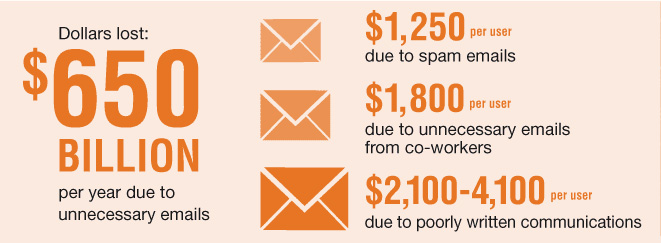Feb 27, 2015
3 Ways to Eliminate Email Overload

Raise your hand if you spent large parts of your day writing and responding to emails during and after work hours. (Raises hand) I am guilty as charged.
Research has shown that this is neither productive/cost efficient nor healthy.
According to the McKinsey Global Institute, on average, only 27 percent of employee email is relevant. That means employees spend 73% of their time sorting through and reading unnecessary emails. We all know that time is money but due to unnecessary email, companies are losing up to $650 billion per year, according to research firm Basex. Do you find this efficient or productive? I don’t.

With access to email on multiple devices, many companies, unknowingly, have set workplace norms about expected email response rates. Employees are obsessively checking work email in AND outside of work as a result. I recently read an article from the Huffington Post, on how “Immediately Responding To Work Email Is Destroying Your Health.” According to this article, research in the upcoming issue of the Journal of Occupational Health Psychology found that obsessively responding to email can be a health hazard with health issues including heavy stress and fatigue.
One thing is clear, to keep the companies bottom-line intact and to ensure the well-being of all employees, it is necessary to reduce unnecessary email and here is how:
1. Create email etiquette guidelines within a corporate email policy
Setting corporate email policies are a blessing in disguise. They not only protect against phishing attacks, avoid employee misconduct, reduce liability for an employee’s actions and warn employees about email monitoring, but they can even be used to educate employees on expected email etiquette.
In addition to the “what not to say” guidelines, common guidelines include:
- Use the infamous “cc,” “bcc” and “replay all” sparingly
- Write well-structured emails/subject lines that are concise and to the point
- Avoid email conversations especially when only writing back one word like “Thanks” or “Ok”
- Thoroughly read the email and send a complete response
- Include an email signature and avoid adding personal quotes to it
2. Reduce email (Scary, I know!)
As scary as it sounds, some companies are attempting to eliminate or reduce email in the workplace as a way to collaborate more efficiently and save money. Thierry Breton, CEO of Atos — one of the largest information technology companies in the world, in a press release in 2011 announced his plans to completely rid the company of work email as a collaborative medium. While they are not completely email-free yet, in 2014, Forbes reported that Atos has seen success with customer issues being resolved up to 30% faster as a result.
While not everyone has adopted the Atos approach, companies like Volkswagen, have a “no email after-hours policies,” in which they stop the servers from being able to send email. Other companies also encourage employees to take email breaks or are finding innovative solutions.
3. Leverage internal social media and intranets
With or without workplace email, adopting innovative social tools in the workplace can be just what your business needs. Social networks such as Yammer or intranets created through programs such as SharePoint promote discussion between all departments in real time through instant messaging, and allow employees to subscribe to networking groups and provide status updates. Facebook-like collaboration platforms like these that are enabled with chat, video, commenting and more allow for employees to easily get the information they need and work more efficiently through increased knowledge sharing and two-way dialogue. Social networks can ultimately drive business performance as shown in Gagen MacDonald’s “10 Things Your Intranet Could Be Doing For You Right Now.”
Need to know where to start or need help refreshing your current layout? Contact Gagen MacDonald to learn how to unleash the power of your own social network today!